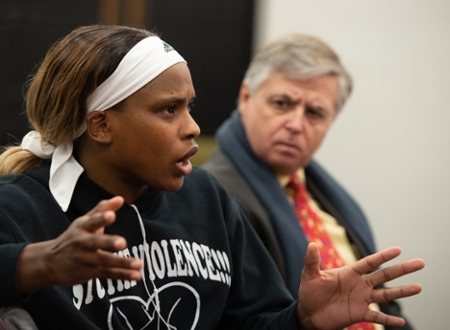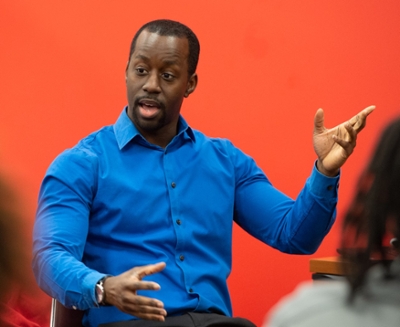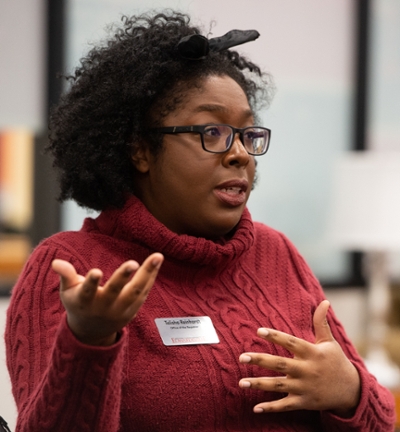 Negative preconceived ideas, feelings of isolation and virtually no exposure to black scholars are struggles that black students face in college classrooms at predominantly white institutions (PWIs), according to Timothy Lewis, PhD, assistant professor in the Southern Illinois University Edwardsville Department of Political Science.
Negative preconceived ideas, feelings of isolation and virtually no exposure to black scholars are struggles that black students face in college classrooms at predominantly white institutions (PWIs), according to Timothy Lewis, PhD, assistant professor in the Southern Illinois University Edwardsville Department of Political Science.
Lewis, who specializes in identity politics, facilitated the Inclusive Conversation, “Being Black in the Classroom,” which was held Friday, Feb. 21 in the Center for Student Diversity and Inclusion (CSDI).
Lewis introduced the discussion of equity within the educational system by presenting a 1960s video of renowned American novelist, playwright, poet and activist James Baldwin. In the video, Baldwin spoke about race and racism.
“I don’t know what most white people in this country feel … I can only conclude what they feel by the state of their institutions,” said Baldwin.
“What do the institutions of America tell you about race?” asked Lewis. “In particular, what is the state of education for blacks?”
Lewis shared Pew Research studies that showed two reoccurring themes in U.S. education:
- Being black merits suspicion. Black students are more likely to be punished and more likely to have more severe punishments (Balingit, 2018).
- Blacks are unintelligent (different than the inherit bias of standardized testing).
 “I’ve been in honors classes where I was asked, ‘How did you get in here?’” said Christen King, a senior, majoring in criminal justice and SIUE women’s basketball player. “I’ve also been told that I speak well. It’s hurtful.”
“I’ve been in honors classes where I was asked, ‘How did you get in here?’” said Christen King, a senior, majoring in criminal justice and SIUE women’s basketball player. “I’ve also been told that I speak well. It’s hurtful.”
“Additional data from Pew Research, shows that the manifestations of racism and racial bias are experienced more frequently in college than in high school or grade school,” added Lewis. “Why do you think that is?”
“A majority of people go to grade school and high school in the neighborhoods where they live,” interjected King. “Most neighborhoods and schools are not overly diverse.”
Many college students had no exposure to an African American instructor in their K-12 experience, according to Lewis.
“This means that during the years of the most influential cognitive development, the classroom was a space where blackness as the authority did not exist,” he added. “There have been some students at SIUE who were surprised to learn I was a professor.”
Lewis continued the discussion by asking what is the harm in educational spaces remaining predominantly white.
“In some cases, it allows students to absorb stereotypes,” said Tarsha Moore, CSDI assistant director. “The absence of interaction with black people can validate some negative things seen via social media or mainstream media.”
 “That isolation allows you to stay ignorant,” said Telisha Reinhardt, admissions and records officer in the Office of the Registrar. “I was in the military, and I served with people who had never seen black people before. While military is not a perfect institution, it forced people to look at your fellow sailor with respect, because they may be the one to save your life one day.”
“That isolation allows you to stay ignorant,” said Telisha Reinhardt, admissions and records officer in the Office of the Registrar. “I was in the military, and I served with people who had never seen black people before. While military is not a perfect institution, it forced people to look at your fellow sailor with respect, because they may be the one to save your life one day.”
SIUE Chancellor Randy Pembrook asked the group how their perspectives would change if the University were to drastically increase the diversity of its faculty and staff.
“If I walked in certain classes and saw black faculty, that would be uplifting,” said King.
“I definitely think it will have a positive impact, if we increase those numbers,” remarked Moore. “However, support is also needed. We don’t want to just recruit black faculty, staff and students, we want to retain them as well.”
Photos:
SIUE Chancellor Randy Pembrook listens to the concerns of Christen King, a senior, majoring in criminal justice.
Timothy Lewis, PhD, assistant professor in the Department of Political Science, facilitated the Inclusive Conversation, “Being Black in the Classroom.”
Telisha Reinhardt, admissions and records officer in the Office of the Registrar, offers her point of view.